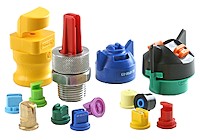Nozzles
Choosing and maintaining the correct nozzles affects both the accuracy and efficiency of agrichemical application.
Nozzle selection
 The type of nozzle you use depends on what you want to spray (i.e. a pest, disease or weed), and what type of spraying equipment you're going to be using.
The type of nozzle you use depends on what you want to spray (i.e. a pest, disease or weed), and what type of spraying equipment you're going to be using.
Standard flat fan nozzles are a general purpose nozzle. They produce a range of droplet sizes at low pressures (100–400 kPa) depending on individual nozzle design. They deposit more spray in the centre of the spray zone than at the edges so they need to be set up to allow overlap from adjacent nozzles for even coverage. They are commonly used on boom sprayers in field crops and vegetables.
Even flat fan nozzles are used for applying herbicides in bands across or between crop rows. They produce medium to large droplets at low pressure and deposit a uniform spray pattern across the spray zone. They are commonly used for single nozzle applications e.g. knapsacks.
Hollow cone nozzles are used with knapsacks and airblast sprayers for low volume application of insecticides and fungicides, and sometimes for herbicides. They produce small droplets at moderate to high pressures (500–2000 kPa) and are preferred when spraying dense tree/vine canopies.
Full cone nozzles produce a solid circular, even footprint and are ideal for use with knapsacks for spot spraying.
Air induction (AI) nozzles produce large, air-filled, coarse droplets, substantially reducing the risk of spray drift. AI nozzles produce either a wide angle flat fan of hollow cone pattern. High pressure AI nozzles are used for broadcast spraying of herbicides, fungicides and insecticides using air blast and boom sprayers. Low pressure versions are available for knapsack sprayers.
Nozzle wear
The rate at which nozzles wear depends on the abrasiveness of the liquid, the pressure used and the material used to make the nozzle. A worn nozzle means that spray quality and spray pattern will both be compromised.
Worn nozzles put out more spray, affect spray width and produce larger droplets. The rate of nozzle wear depends on several factors including nozzle material, pesticides used, operating pressure and output.
Ceramic nozzles are the most resistant to wear, followed by plastic and stainless steel. Brass nozzles wear quickly, particularly when used to apply abrasive products such as wettable powders, and they are corroded by some liquid fertilizers.
Check each nozzle regularly for wear and tear. Before every spraying job check the spray pattern from each nozzle – look for obvious striping or blockages.
Nozzle maintenance
At regular intervals throughout the season check nozzle output against manufacturer's recommendations. One way of doing this is to keep a new nozzle from a set and compare used nozzles with it to assess their condition over time. Nozzles should be replaced when their output (i.e. flow in litres per minute) has increased by 10% or more and at least every year. This can be assessed by reference to nozzle selection charts.
To clear blocked nozzles, soak in water and clean with a brush and airline. For stubborn deposits soak in warm water and detergent, agitating occasionally. Never blow through a nozzle or poke with wires or pins - even the slightest damage to the orifice will alter flow rate angle and spray distribution.